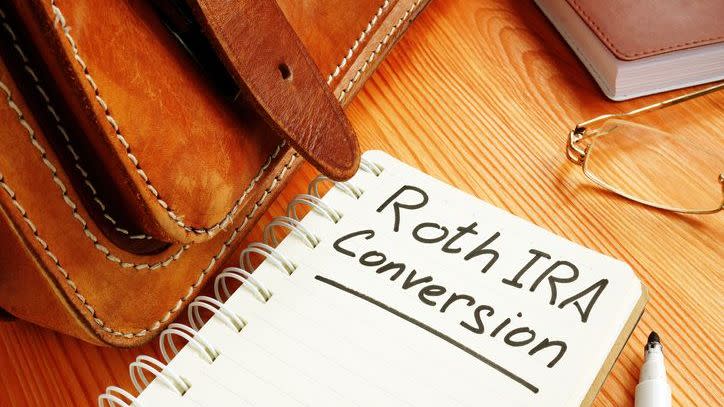Imagine you’re 65 with $1.2 million in an IRA and a lingering question: Should you convert your account to a Roth IRA? The answer may depend on how you approach it. A Roth conversion can provide some significant benefits, including tax-free withdrawals and freedom from required distributions — but that doesn’t mean it’s always the right move.
While there is no prohibition or disadvantage to a Roth conversion based on your age at 65, converting the entire $1.2 million at once will leave you with a higher tax bill than you want to pay in a single year. However, if you use partial Roth conversions tailored to your situation, you can significantly reduce your tax burden and also provide for a tax-free inheritance later in life. If you need additional guidance on Roth conversions and other retirement planning topics, contact a financial advisor today.
Roth IRA Conversion Concepts
A Roth conversion moves retirement money from a traditional IRA to a Roth IRA. Traditional pre-tax IRAs let you deduct contributions from taxable income when you contribute, but withdrawals during retirement are taxed at your income tax rate that year.
Roth IRA contributions use after-tax dollars, so you won’t get a tax benefit from making contributions. However, qualified withdrawals can be made tax-free later. Another big plus is that Roth accounts are not subject to required minimum distributions (RMDs), which could put you in a higher tax bracket in retirement. Without RMDs, Roth funds can remain invested forever and grow tax-free, passing on to your heirs if that’s part of your estate plan. There is also no income limit on Roth conversions, unlike direct contributions to a Roth IRA which can only be made by individuals with less than $161,000 in adjusted gross income (MAGI) and married couples with less than $240,000 in combined MAGI submit.
But Roth conversions come with a major catch. The money you convert in one year simply becomes income in the year it’s converted. That means you’ll have to pay taxes on that money – potentially a lot of taxes. Converting $1.2 million into taxable Roth conversion income could result in a top federal rate of 37%, plus state taxes in most states. An alternative approach to reducing this potential tax burden is to do partial conversions, where you spread a large amount over several years to avoid falling into a higher bracket.
And if you’d like to discuss your options with an expert, consider using this free matching tool to find a financial advisor.
Lump sum vs. incremental conversions


As a single 65-year-old with $1.2 million in a traditional IRA, let’s assume you receive $24,000 in annual Social Security income, which is slightly more than the most recent average retirement benefit of $1,856 per month. If you were to convert the entire $1.2 million IRA balance to a Roth IRA in 2023 and take the standard deduction ($15,700 in 2023 for people age 65 and older), all or nearly all of the converted amount could be subject to are subject to the highest tax rate of 37%. This could result in a one-time federal tax revenue bill of more than $398,000 due in April 2024, plus more if state taxes apply.
Need help with a Roth conversion? Find a financial advisor today.
There might be a better way. Spreading the $1.2 million conversion over 10 years at $120,000 per year puts you in the 22% tax bracket in tax year 2023 after deducting the standard deduction. That means you’ll pay about $18,430 in federal taxes annually on the portion that converts. Over the decade, that amounts to about $184,300, for a total tax savings of about $214,000. (Although the tax brackets change from year to year, we’ll assume you stay in the 24% bracket, for simplicity.)
People under age 59½ should be aware of the five-year rule when making a Roth conversion. Withdrawing money from a Roth account less than five years after a conversion could result in a 10% penalty. However, that rule does not apply to people age 59½ or older, or to others who qualify for certain exceptions.
More Roth Conversion Considerations
There are a number of other factors to keep in mind. First, adding taxable income from a Roth conversion can increase taxes on your Social Security benefits. You may also have to pay higher Medicare premiums and lose access to certain tax credits.
Additionally, the money you leave in the Roth while you make partial conversions will likely continue to grow, so you’ll need to convert more than $120,000 in later years to clear the account. In addition, future tax rates may increase. These uncertainties mean that any projections of taxes due on the gradual conversion plan may differ significantly from the actual amounts you will owe. Converting everything now offers certainty – you know exactly how much you have to pay.
Deciding if a Roth Conversion is Right for You


There are a lot of moving parts when evaluating a major Roth conversion. You can follow this process and talk to a financial advisor to gain a better understanding of how this maneuver will affect your prospects:
-
Decide how you want to handle IRA money upon your death. If the goal is a completely tax-free inheritance, calculated partial Roth conversions can maintain that tax-free growth for heirs over time.
-
Compare current and future expected tax rates. Paying tax now on a lump sum conversion or a series of larger conversions could ultimately save you if tax rates rise in the future.
-
Consider other elements of your financial plan. Examine your income streams, multi-year tax outlook, health care costs, and estate planning. Choosing the Roth conversion method that works best for you will likely require a careful and comprehensive analysis of your financial outlook.
In short
While you can make a Roth conversion at any age, converting an entire $1.2 million IRA to a Roth account all at once will typically leave you with a large tax bill. However, partial Roth conversions tailored specifically to you can help significantly. Review retirement plans, estate planning, healthcare budgets, and more before you opt to convert. Also, consider potential future changes in tax rates and how they could impact you.
Retirement planning tips
-
A financial advisor can help you evaluate whether a Roth IRA conversion makes sense for you. Finding a financial advisor doesn’t have to be difficult. SmartAsset’s free tool matches you with up to three vetted financial advisors who serve your area, and you can schedule a free introductory meeting with your advisors to decide which one you think is right for you. If you’re ready to find an advisor who can help you achieve your financial goals, get started now.
-
SmartAsset’s Social Security calculator is a quick and easy way to project the size of your monthly check after you file for benefits. If you’re considering moving to a new state for retirement, it’s important to assess that state’s tax environment. SmartAsset’s Retirement Tax-Friendliness Tool can help.
-
Have an emergency fund on hand in case you encounter unexpected expenses. An emergency fund should be liquid – in an account that is not at risk of significant fluctuations like the stock market. The trade-off is that the value of liquid cash can be eroded by inflation. But with a high-interest account, you can earn compound interest. Compare savings accounts from these banks.
Photo credits: ©iStock.com/designer491, ©iStock.com/Pekic, ©iStock.com/insta_photos
The post I am 65 years old with $1.2 million in an IRA. I’m Taking Social Security – Is It Too Late to Switch to a Roth IRA? first appeared on SmartReads by SmartAsset.







